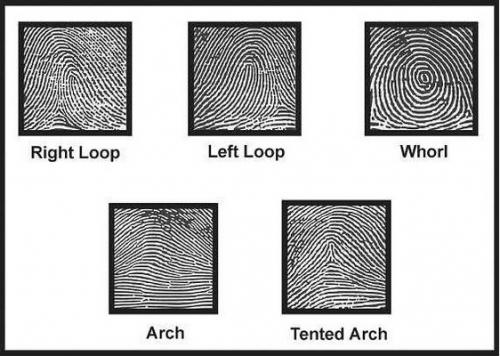ForensicsNew technique can tell whether a fingerprint belongs to a male or female
Culprits beware: researchers are taking crime scene fingerprint identification to a new level. They have discovered a straightforward concept for identifying whether a culprit is male or female. It is based on the content in fingerprints — specifically amino acids. Amino acid levels in the sweat of females are about twice as high as in males. There is also a slightly different distribution, due mostly to hormonal differences. The same is true for amino acids left behind in fingerprints.

Fingerprint patterns used in fingerprint identification // Source: uah.edu
Culprits beware, a University at Albany research group, led by assistant chemistry professor Jan Halámek, is taking crime scene fingerprint identification to a new level.
Halámek and his team of researchers at UAlbany have discovered a straightforward concept for identifying whether a culprit is male or female. It is based on the content in fingerprints — specifically amino acids.
According to known literature, amino acid levels in the sweat of females are about twice as high as in males. There is also a slightly different distribution, due mostly to hormonal differences. The same is true for amino acids left behind in fingerprints. Halámek’s research team has devised a simple method to back up these claims.
UAlbany reports that as a starting point, Halámek’s team extracts amino acids from a fingerprint by transferring it onto a piece of plastic wrap. A hydrochloric acid solution is then placed onto the fingerprint, followed by heating. This process allows for the water-soluble amino acids to migrate into the acidic solution. From there, the team can easily view amino acid levels, distinguishing sex.
Halámek and his colleagues first test this method on “mimicked fingerprint samples,” which they found to have a 99 percent accuracy of correct sex classification. From there, they set up a real crime scene scenario. Three female volunteers placed their fingerprints on five different surfaces, including a doorknob and a computer screen. Regardless of the surface type, Halámek’s team found it was possible to tell the fingerprint belonged to a woman.
“One of the main goals for this project was to move toward looking at the chemical content within the fingerprint, as opposed to relying on simply the fingerprint image,” Halámek said. “We do not intend to compete with DNA analysis or the databases used for identification. Instead we are aiming at differentiating between demographic groups, and more importantly, we are aiming at making use of fingerprints that are smudged/distorted or that don’t have an existing match.”
According to Halámek, this is only the beginning of his research. He’s currently in the process of developing additional identification methods for other forensically-relevant attributes, as well as improving on the current fingerprint concept.
— Crystal Huynh et al., “Forensic Identification of Gender from Fingerprints,” Analytical Chemistry 87, no. 22 (13 October 2015): 11531–36 (DOI: 10.1021/acs.analchem.5b03323)
